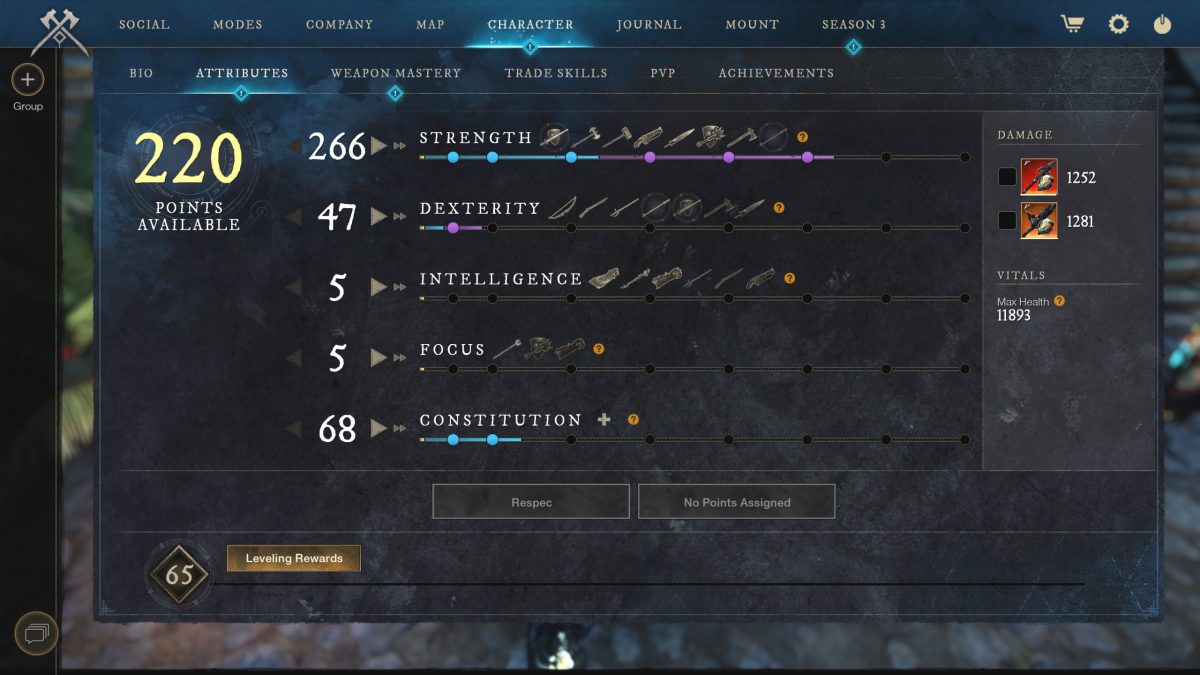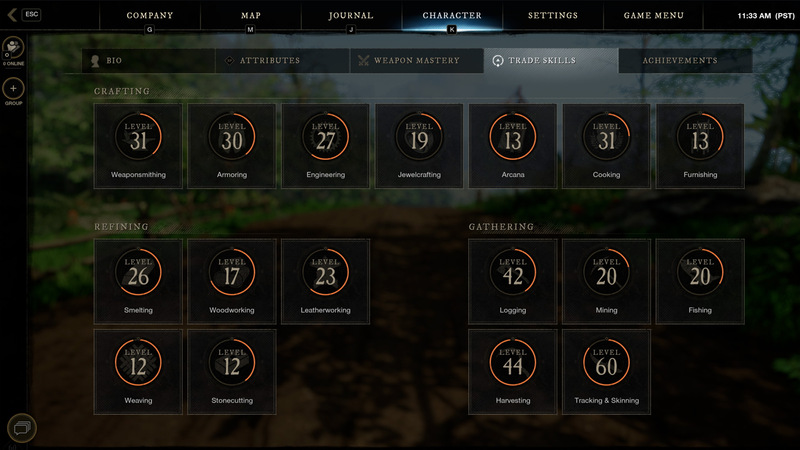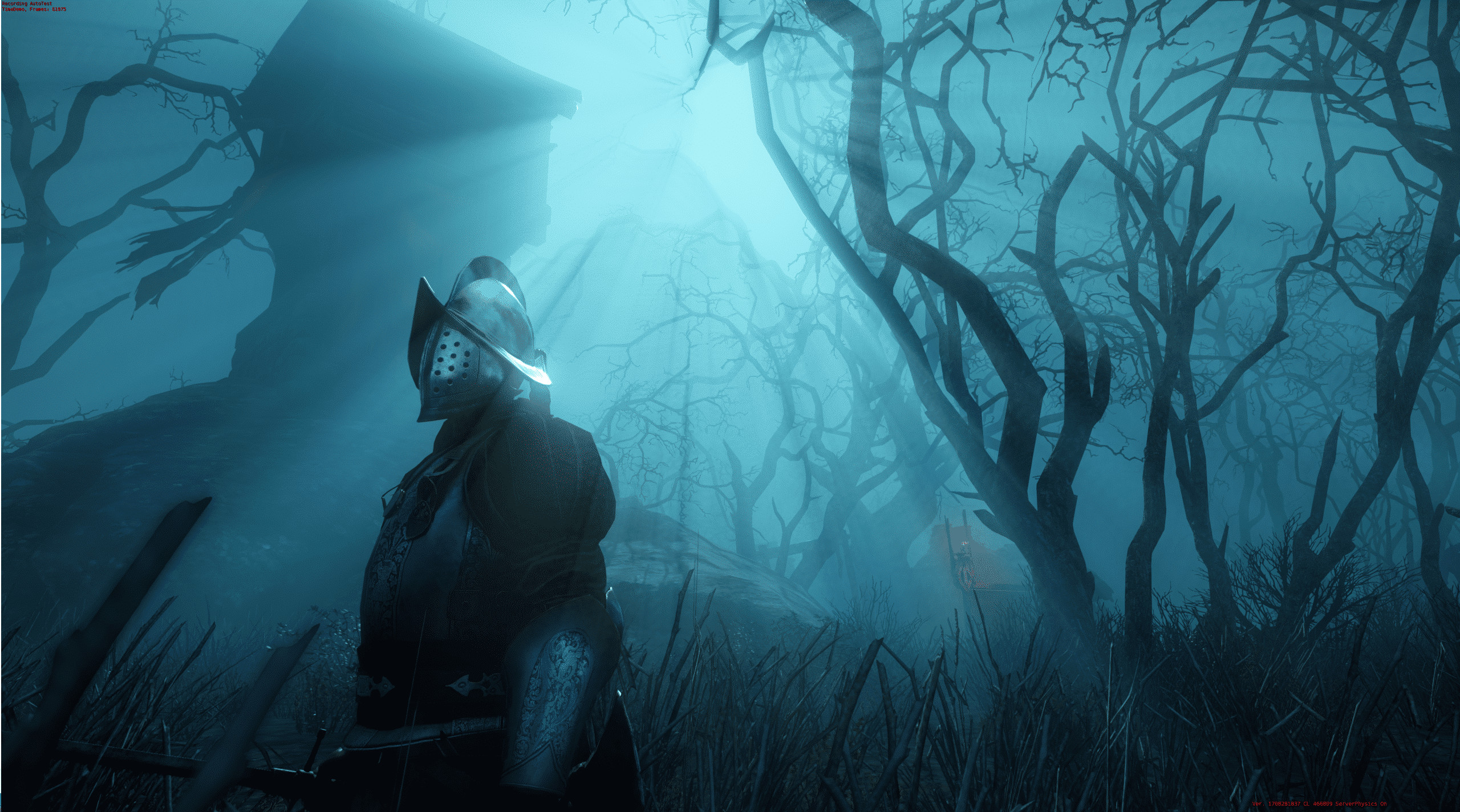Introduction
There are 3 main areas of New World character progression. You gain experience towards your overall character level and will level up once you gain enough XP. Upon leveling up you will be awarded attribute points that can be used to increase one of 5 attributes in the game. Upon reaching max level, progressions shift from leveling up your character to leveling up your Gear Score.
You will also gain experience for each weapon type you use in the game. Upon receiving enough experience for a particular weapon, you will be awarded a weapon mastery point to be spent on either an active or passive ability within that weapon’s skill trees. Another form of the main progression will come in the form of trade skills. Trade skills consist of gathering, refining, and crafting.
Core Attributes & Character Levels
As your character levels, you will gain attribute points per level up to a total of 220 upon reaching the max character level of 65. You can also gain attribute points from gear. Upon visiting Aeternum for the first time your character will have 5 points in each of the core attributes. You can not drop below that 5-point minimum.
The points you earn while leveling your character can then be spent to level up your attributes, and those core attributes ultimately guide your overall build. How you spend those attribute points as you level will be crucial to your success in New World. As mentioned before, New World does not have a class based system so you have to make sure you tie your attribute points into the weapons you are wanting to use.
Attributes
Strength increases the amount of damage you do with melee weapons. Some melee weapons scale exclusively from strength and other, lighter weapons scale primarily from strength and some from dexterity.
Dexterity is the attribute that scales your damage with ranged weapons such as the bow and musket.
Intelligence is the attribute you’ll want to spec into if you’re looking to gain damage from your magical weapons, such as the fire staff and ice gauntlet. If you’re planning on maining a healer, focus is the attribute you’ll be speccing into.
The last attribute is constitution, and it’s pretty straightforward. Putting points into constitution increases your overall health pool making you much tankier.
Each attribute also has attribute threshold bonuses. Attribute Threshold Bonuses give a persistent bonus to players for maintaining certain point values in each attribute. Bonuses are awarded for the first 25 points and then every 50 points invested in a single attribute thereafter (e.g., at 25, 50, 100, or 150 points invested). Each threshold has a combat bonus and a non-combat bonus.

If you feel like you’ve messed up your build or simply want to re-roll a build it is possible to re-spec your attribute points early on for free and then later down the road by paying coin to do so.
End Game Progression
Upon reaching level 65, your progression will shift from leveling up your character to increasing your gear score. Your gear score is determined by the items you have equipped. In order to increase you gear score you can perform chest runs in high level areas, run expeditions and mutations, engage in PvP activities, and more. For an in depth explanation on how to reach 700 gear score you can check out our ‘How to Get to 700 Gear Score‘ guide.
Weapon Masteries
Another form of New World character progression is the weapon system. In New World, you can equip any weapon at any time. Your character is not locked to a specific weapon based on a class you pick. New World does not have a class-based system and you can master every single weapon in the game if you so choose.
Once you have a weapon equipped you then just need to go use that weapon in combat and kill a creature to gain experience for that particular weapon’s mastery. Once you have gained enough weapon mastery experience you will then be rewarded with a skill point that can be spent on ability within the skill trees of that weapon.
Every weapon in the game has 2 separate skill trees, and each one of the skill trees has a selection of active abilities, passive modifiers, and bonuses that are exclusive to that weapon that can be specced into as you progress down the skill trees.
Mastery Points
Earning Mastery Points for each weapon is a key part of New World Character Progression. It’s important to point out here that each weapon maxes out at level 20, and each weapon has a total of 19 abilities on each tree, totaling 38 abilities. This means that you can not learn every skill the weapon has to offer and will have to choose which abilities you want in your build.
You are not limited to going down one tree or the other, so you could decide to put, for example, in the hatchet weapon mastery trees, 10 points into the berserk tree and 9 points into the throwing tree if you wanted to go that route.
Each tree within a weapon mastery has 3 active abilities. You can equip 2 weapons, and switch between those weapons in combat. This gives you 6 active abilities to cycle through during combat, with each having a separate cooldown.
If you spec into something you don’t like or want to change your build, later on, you can re-spec the entire mastery tree by paying a respec fee using Azoth.
Each weapon in the game also scales off of different attributes. Some of the weapons scale off of a single attribute while others have both a primary and secondary attribute. Listed below are the weapons and what attributes they scale with. The primary Attribute is listed first and the secondary attribute is listed second.
One-Handed Weapons:
Sword & Shield – Strength & Dexterity
Rapier – Dexterity & Intelligence
Hatchet – Strength & Dexterity
Flail & Shield – Strength & Focus
Two-Handed Weapons:
Spear – Dexterity & Strength
Great Axe – Strength
War Hammer – Strength
Great Sword – Strength & Dexterity
Ranged Weapons:
Bow – Dexterity
Musket – Dexterity & Intelligence
Blunderbuss – Strength & Intelligence
Magic:
Fire Staff – Intelligence
Life Staff – Focus
Ice Gauntlet – Intelligence
Void Gauntlet – Intelligence & Focus

Trade Skills
Trade skills are another form of New World character progression, and they are made up of 3 different non-combat categories which include, gathering, refining, and crafting, and there are several skills within each category. The max level of any trade skill is 250. However, you can progress past 250 and receive rewards via the aptitude system.
Gathering
New World Gathering is broken down into 5 different skill lines which include fishing, mining, skinning, logging, and harvesting. To progress, or level up a gathering skill you simply have to use that particular skill. The more you use it the better you become at performing that task. If you want to know more about gathering visit our gathering guide.
Refining
There are 5 different skill lines within the refining category which are smelting, stone cutting, woodworking, tanning, and weaving.
Smelters refine ore into ingots, stone cutting is used to refine stone into blocks and cut gemstones into gems in order to socket them into gear, woodworkers cut wood into lumber, tanners refine hide into leather, and weavers turn fiber into usable cloth.
In order to level up each skill line you simply have to refine more materials.
As you level up in a particular skill you will unlock the ability to refine higher quality resources which are in turn used to craft higher quality gear. You also become much more resource-efficient as higher-level refiners have a chance to gain extra refined resources while they refine.
Crafting
There are seven different crafting skills in New World including weaponsmithing, armoring, jewelcrafting, engineering, arcana, cooking, and furnishing.
Just like with gathering and refining the more you craft within a particular skill line the higher you will progress within that particular line. So, if you want to make the best weapons in the game you would just acquire the needed materials, make your way to the applicable workstation in a settlement, and craft as many weapons as possible in order to level up your weaponsmithing skill.
Leveling a crafting skill will unlock more recipes and allow you to craft higher-tier items. The tier of items ranges from tier 1 being the lowest to tier 5 being the highest.
It’s also important to note that in order to craft a specific tier item the crafting station you are using must be at or above that tier. You can learn about leveling up crafting stations by visiting our settlements guide.
Music
The Music Trade Skill allows you to apply buffs to you and your allies by playing songs. In order to level this skill you simply need to play a song to gain experience. For more on New Worlds music Trade skill, check out our music guide!

Riding
The riding skill in New World is what affects how fast you can ride on your mount. In order to level your riding skill you can feed your mount or complete mount quests. For a full in depth riding and mount guide you can check out our ‘Mounts in New World‘ guide.
New World Character Progression Conclusion
This concludes our New World Character Progression Guide. For more on leveling your character in New world, check out our New World Leveling Guide.

